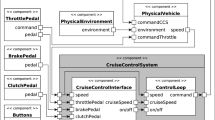Abstract
The use of good (formal) specifications of software components produces a good characterization of their functionalities. This fact eases the modifiability of a module specification due to a change of requirements or to the need of an enhancement of its functionalities after the delivery to the users, and then, in general, eases also the reusability of a module. Moreover, if existing modules have a specification not based on a natural language but on the well-given syntax of a specification language, it is possible to process the needed modifications in an automatic way. This work presents a method to derive the modifications of the specification of an existing module (given by means of the LOTOS language) from a characterization of the environment, in which the new module has to be used, given by means of temporal logic formulae. The method consists of tableau-based rules that build the due modifications, and always produces a fitting solution for formulae that can be satisfied and belong to a given class.
Similar content being viewed by others
References
Barbuti, R., De Francesco, N., Santone, A. and Vaglini, G.: Selective mu-calculus: New modal operators for proving properties on reduced transition systems, in Proceedings of FORTE X/PSTV XVII’ 97, Chapman & Hall, 1997, pp. 519-534.
Barbuti, R., De Francesco, N., Santone, A. and Vaglini, G.: Selective mu-calculus and formula-based abstractions of transition systems, J. Comput. System Sci. 59(3) (1999), 537-556.
Biggerstaff, T. J. (ed.): Software Reusability, Vol. 1: Concepts and Models, ACM Press, New York, 1989.
Bolognesi, T. and Brinksma, E.: Introduction to ISO specification language LOTOS, Comp. Networks and ISDN Systems 14 (1987), 25-59.
Emerson, E. A. and Clarke, E. M.: Using branching time temporal logic to synthesize synchronization skeletons, Sci. Computer Programming 2(3) (1982), 241-266.
Jeng, J. J. and Cheng, B. H. C.: Specification matching for software reuse: A foundation, in Proceedings of the ACM SIGSOFT Symposium on Software Reusability (SSR’95), 1995, pp. 97-105.
Kozen, D.: Results on the propositional mu-calculus, Theoret. Comput. Sci. 27 (1983), 333-354.
Krueger, C. W.: Software reuse, ACM Comput. Survey 24(2) (1992), 131-183.
Larrabeiti, D., Quemada, J., Pavon, S. and Fernandez, A.: A practical approach to testing finite state systems, in Proceedings of COST-247 2nd International Workshop on Applied Formal Methods in System Design, 1997.
Larsen, K. G. and Xinxin, L.: Compositionality through an operational semantics of contexts, in Proceedings of ICALP’90, Lecture Notes in Comput. Sci. 443, 1990, pp. 526-539.
Larsen, K. G. and Xinxin, L.: Equation solving using modal transition systems, in Proceedings of 5th Annual IEEE Symposium on Logic in Computer Science, IEEE Computer Society Press, 1990, pp. 108-117.
Maler, O., Pnueli, A. and Sifakis, J.: On the synthesis of discrete controllers for timed systems, in Proceedings of 12th Annual Symposium on Theoretical Aspects of Computer Science (STACS’95), Lecture Notes in Comput. Sci. 900, Springer, 1995, pp. 229-242.
Manna, Z. and Wolper, P.: Synthesis of communicating processes from temporal logic specifications, ACM Trans. on Programming Languages and Systems 6(1) (1984), 68-93.
Milner, R.: Communication and Concurrency, Prentice-Hall, 1989.
Parrow, J.: Submodule construction as equation solving in CCS, Theoret. Comput. Sci. 68(2) (1989), 175-202.
Petrenko, A. and Yevtushenko, N.: Solving asynchronous equations, in Proceedings of FORTE/PSTV’98, 1998, pp. 231-247.
Pnueli, A. and Rosner, R.: On the synthesis of a reactive module, in Proceedings of ACM Symp. POPL’89 24(2), 1989, pp. 179-190.
Qin, H. and Lewis, P.: Factorization of finite state machines under strong and observational equivalences, Formal Aspects of Computing 3 (1991), 284-307.
Quemada, J., Pavon, S. and Fernandez, A.: Transforming LOTOS specifications with LOLA - the parameterized expansion, in Proceedings of FORTE’ 88, 1988, pp. 45-54.
Ramadge, P. J. and Wonham, W. M.: Supervisory control of a class of discrete event processes, SIAM J. Control Optim. 25 (1987), 206-230.
Santone, A. and Vaglini, G.: Reusing software components by means of automatable formula-based integrations, Technical Report PI-DII/7/2000, July 2000.
Stirling, C.: An introduction to modal and temporal logics for CCS, in Concurrency: Theory, Language, and Architecture, Lecture Notes in Comput. Sci. 391, Springer, 1989.
Author information
Authors and Affiliations
Rights and permissions
About this article
Cite this article
Santone, A., Vaglini, G. Modifying LOTOS Specifications by Means of Automatable Formula-Based Integrations. Journal of Automated Reasoning 30, 33–58 (2003). https://doi.org/10.1023/A:1022561505762
Issue Date:
DOI: https://doi.org/10.1023/A:1022561505762




